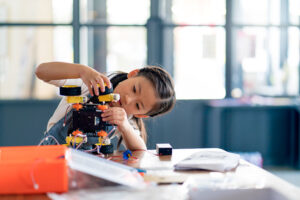How STEM learning helps to build better futures for children

When you consider that 100 years ago, scratching yourself could easily lead to sepsis and an early death, you realise how far we’ve come in the last century. Penicillin, air travel, GPS systems, and countless other life-enhancing technologies have been created, all thanks to the students who decided to pursue careers in science, technology, engineering or mathematics (STEM).
But despite technologies developing ever-faster, opening up swathes of fresh opportunities for students, many are being left behind.1 And Australian businesses need workers with STEM skills. Students who don’t equip themselves with these valuable abilities are limiting their career opportunities in lucrative fields like engineering, software development and medicine; industries where they can make successful, fulfilling lives for themselves.
In this article, we expand on the importance of providing good STEM learning opportunities for Australian students, particularly those in regional, rural and remote schools. We go back to basics and talk about what STEM actually is, and also explore some ways that your school can help to improve STEM learning.
Let’s get started.
What is STEM and why is it important?
STEM is the integrated study of science, technology, engineering and mathematics. They were first combined back in 2001 by the National Science Foundation in the US, who realised how important the skills were for a healthy economy.2 Some even consider STEM a national security risk given how important it is for economic growth.5
“Changing just 1% of the country’s workforce into STEM-related roles would add $57.4 billion to GDP”3
According to PricewaterhouseCoopers, STEM affects Australia’s future prosperity too. In a 2015 report they estimated that changing just 1% of the country’s workforce into STEM-related roles would add $57.4 billion to GDP.3 Artificial intelligence, automation and robotics are just a few examples of emerging industries that may become huge, not to mention the numerous existing industries that have been around for decades.
In 2015 Professor Hugh Bradlow, president of The Australian Academy of Technological Sciences & Engineering (ATSE), claimed that Australia will need 100,000 more digitally-skilled workers by 2024. By 2030, he thinks that up to 30% of existing jobs might be displaced by automation.7 30%!
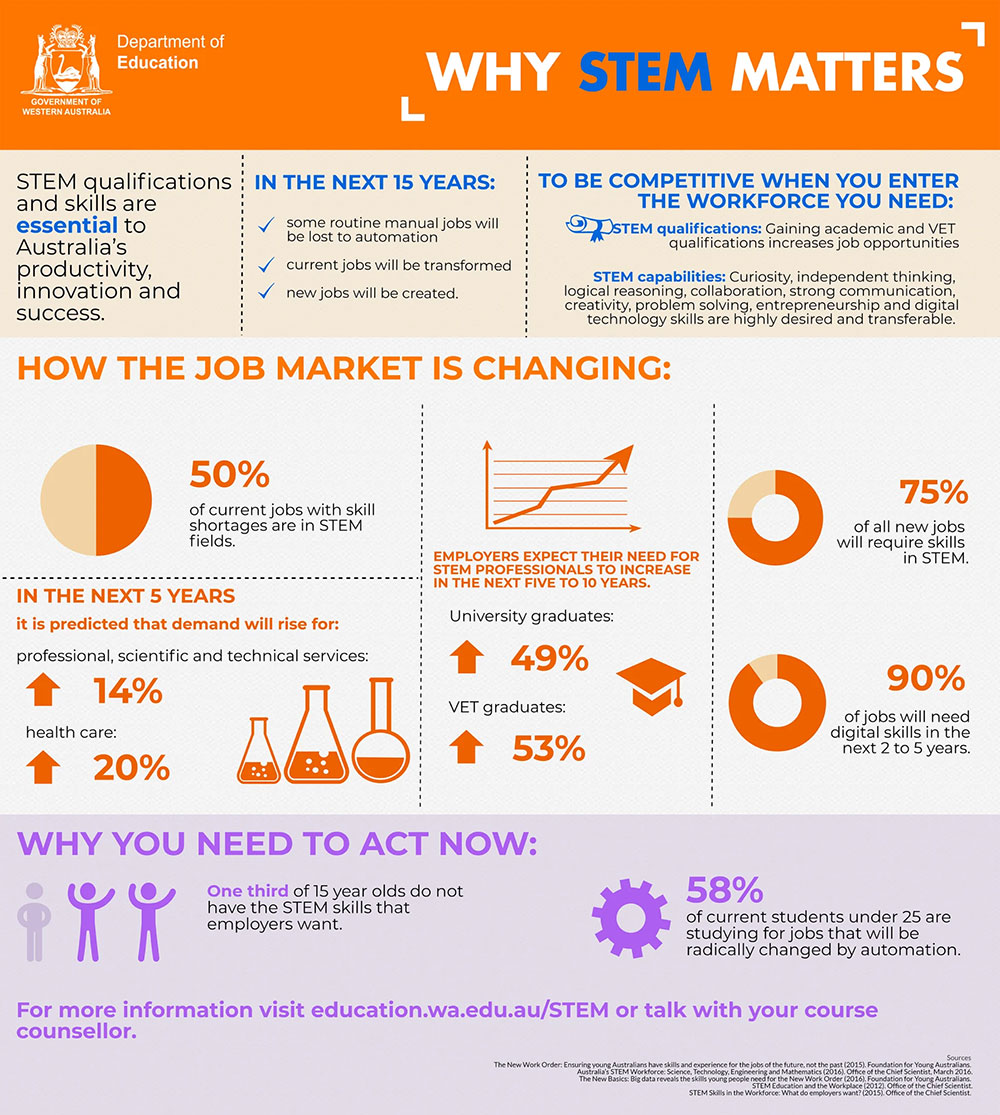 Why STEM matters – Image from the Department of Education WA
Why STEM matters – Image from the Department of Education WA
In Australia, schools don’t typically teach STEM as an integrated subject. Students still learn STEM skills in their maths, science and technologies classes, however, vital as these are, they can lack context and students may struggle to understand how the skills combine in the real world. By teaching STEM as an integrated subject, or teaching standalone STEM-related topics like motion or thermodynamics, teachers can give students much simpler versions of cross-disciplinary tasks that might be undertaken by industry professionals – designing roofs that don’t get too hot, constructing bridges that can hold up against weight, and even building cars. These tasks require a blend of skills from each individual subject, allowing students to learn them in an integrated, contextual way that actually reflects what happens in industry.
You can imagine how much more this resonates with students compared with learning the skills individually, particularly how enjoyable it is – they actually get to build stuff! They can also experiment with skills they might use in their careers, playing scientist, engineer or technologist in a safe environment with a teacher to guide them. This opens up new pathways that can lead to engaging, satisfying vocations – software developers who refine self-driving cars; civil engineers who design eco-friendly cities; life-saving scientists who develop vaccines that inoculate the world, and countless other opportunities that are good for both student and economy.
“With STEM, students can experiment with skills they might use in their careers, playing scientist, engineer or technologist in a safe environment with a teacher to guide them.”
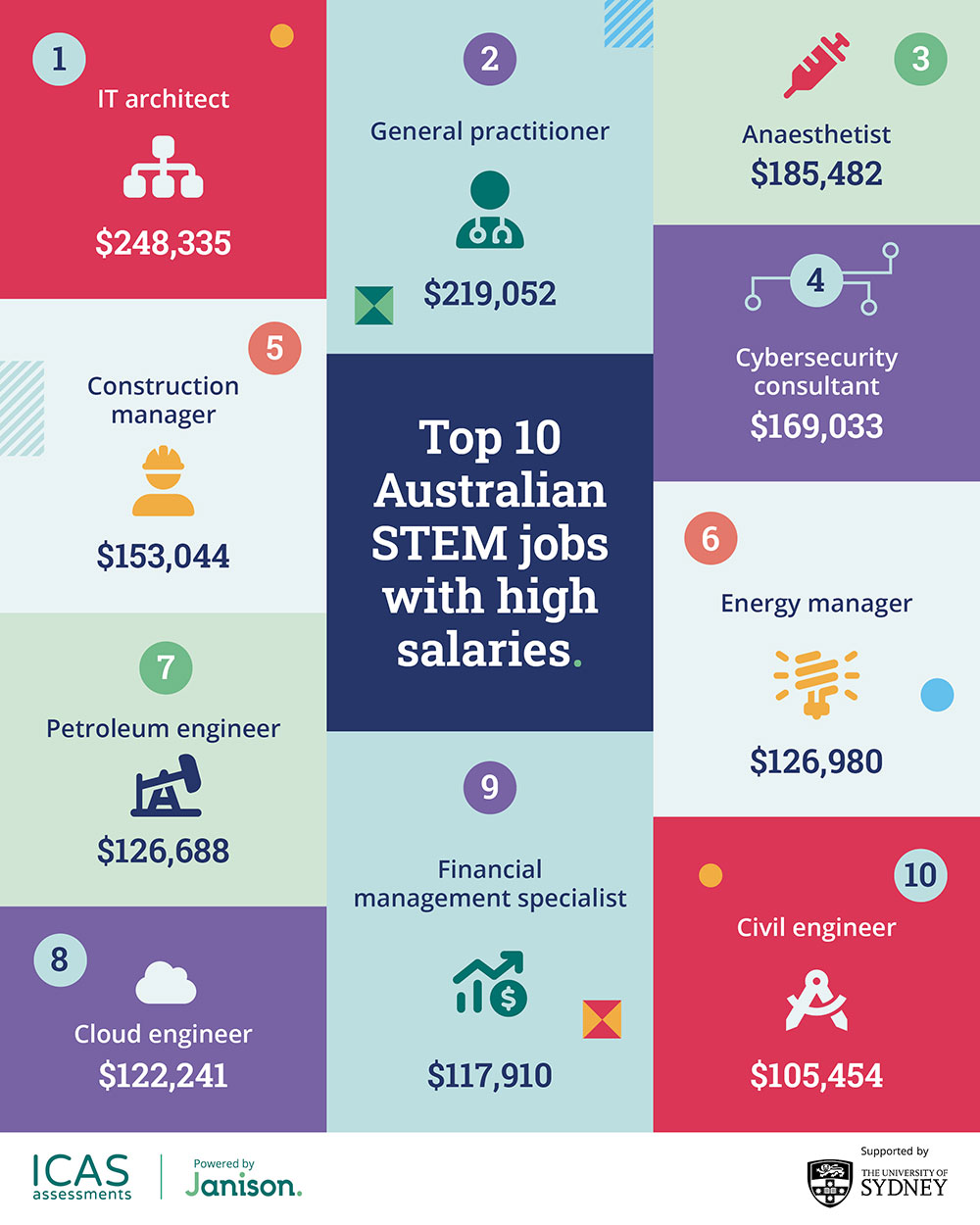 Data from Indeed
Data from Indeed
STEM learning has another big benefit: it helps students to develop their higher-order thinking skills. As they work through their challenging STEM tasks, they’re solving problems, thinking critically, being creative, working and talking with each other, evaluating their work, and using many other higher-order thinking skills that are absolutely essential for the modern workplace, STEM-related or not. And these skills flow through to their other classes, improving their education overall.
What about STEM in Australia?
The Australian Government has recognised the importance of STEM learning. In 2015, it executed the National STEM School Education Strategy, with the lofty goal of ensuring that all students finish school with strong foundational STEM skills, and are inspired to take on more challenging STEM subjects.4 Supporting STEM education opportunities within school systems is a key action area in the strategy, but sadly, in a recent report by the Government’s Productivity Commission, students located in regional and remote areas are struggling with the basics: literacy and numeracy.1 The same goes for Aboriginal and Torres Strait Islander students. Without these foundational skills (particularly numeracy, which underpins all STEM learning), pursuing STEM and the opportunities it provides is lowered drastically. The issue is bigger for girls, who are even less likely to engage with STEM education 4 and will almost certainly miss out.
These are tragic circumstances that must be reversed. Every child in Australia deserves a good education and the opportunities that it provides, particularly those in STEM industries. These industries are some of the fastest-growing on the planet and the companies within them need skilled workers, ideally from diverse backgrounds to provide fresh perspectives to the business. This just isn’t possible without good foundational skills and plenty of STEM learning opportunities at school – requirements to become a true “innovation nation.”
But all is not lost. There’s plenty your school can do to improve students’ STEM education. Little-by-little, you can help to open up exciting new career pathways and level the playing field in the process.
How can your school improve STEM learning?
Here are some actionable tactics that can help you to improve STEM learning for your schools’ students. Some of them are challenging and ambitious, and come straight from the government-led National STEM School Education Strategy.
We outline these broadly in the infographic directly below, and in more detail in the text underneath.
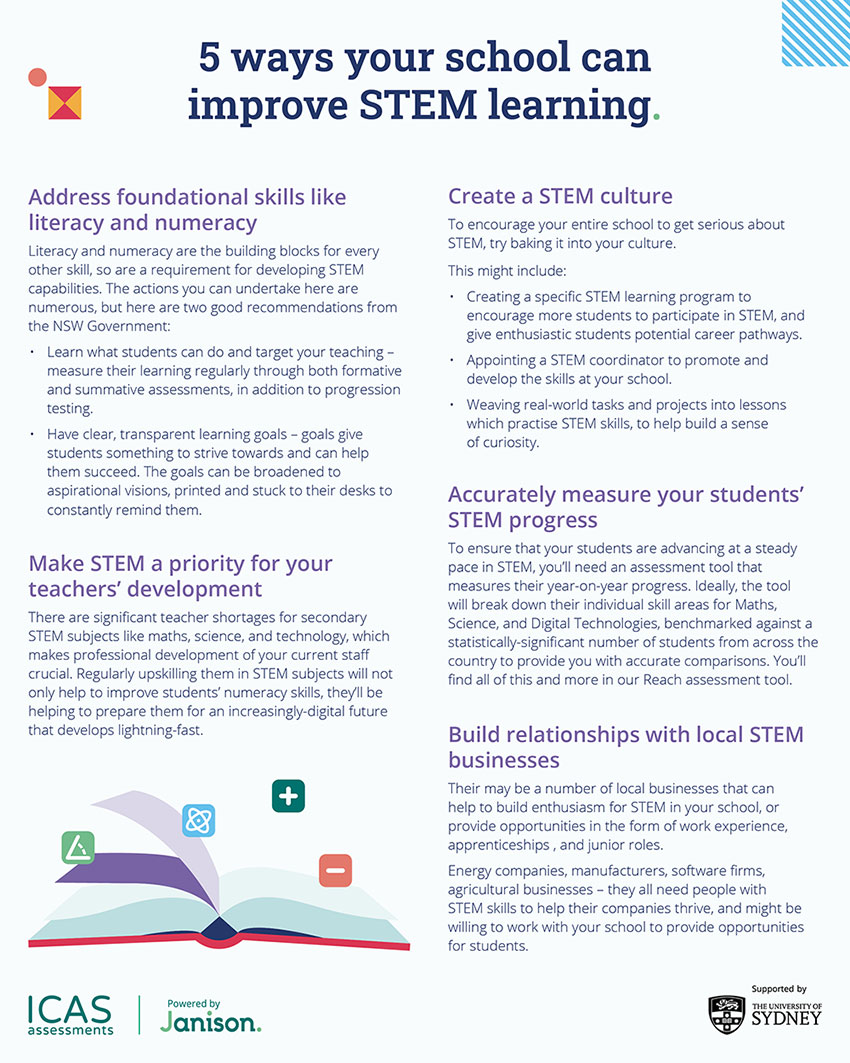
1. Address foundational skills like literacy and numeracy
Perhaps the most challenging task of all, but without doubt the most important. As you well know, literacy and numeracy are the building blocks for every other skill, so are a requirement for developing STEM capabilities.
The actions you can undertake here are numerous, but here are some good recommendations from the NSW Government:6
- Intervene early and maintain focus – ensure that literacy and numeracy are taught from a young age and continued throughout their entire schooling.
- Learn what students can do and target your teaching – measure their learning regularly through both formative and summative assessments, in addition to progression testing. When you have the results, analyse them and change your teaching practices accordingly. Using an assessment tool that includes useful, pre-created reports can help to make sense of the data.
- Have clear, transparent learning goals – goals give students something to strive towards and can help them succeed. The goals can be broadened to aspirational visions, printed and stuck to their desks to constantly remind them.
If you’d like more, you can also check out the Victorian Government’s literacy and numeracy strategy, which is full of good advice.
2. Make STEM a priority for your teachers’ development
“Regularly upskilling your teachers in STEM subjects will not only help to improve students’ numeracy skills, they’ll be preparing them for an increasingly-digital future that develops lightning-fast.”
There are significant teacher shortages for secondary STEM subjects like maths, science and technology. Back in 2018, almost 25% of surveyed teachers had limited or no training in mathematics, 18% for science and 30% for design and technology.7 The problem is intensified for schools that are far away from cities, who have tiny recruitment pools compared to their urban counterparts.
This makes professional development crucial. Whether your school is located in a city or not, regularly upskilling your teachers in STEM subjects will not only help to improve students’ numeracy skills, they’ll be helping to prepare them for an increasingly-digital future that develops lightning-fast.
Now may be the time to review your professional development and figure out where you can make improvements. Are there teachers who are better at STEM who might be able to train others? Can they work together to create strategies for STEM learning? Might it be possible to incentivise STEM abilities for your faculty?
3. Create a STEM culture
Often, STEM gets overlooked in schools because some of the individual skills are considered less important. This couldn’t be further from the truth. By equipping your students with STEM skills, you’re helping to future-proof their careers. And to encourage your entire school to get serious about STEM, you can try baking it into your culture.
This might include:
- Creating a specific STEM learning program, either as part of their daily schooling, or extra-curricular. This will not only encourage more students to participate in STEM, but also give enthusiastic students potential career pathways.
- Appointing a STEM coordinator to promote and develop the skills at your school. They may need to figure out what they can do based on your school’s jurisdiction, take stock of your resources, consider how it fits with what needs to be achieved at the school, and more.
- Inviting local STEM-based businesses to talk to your students about the various career opportunities at their companies (more on this below).
- Weaving real-world tasks and projects into lessons which practise STEM skills, to help build a sense of curiosity. Some students may wonder what they even need to learn maths and science. Real-world tasks provide the answer.
- Engaging in academic competitions like ICAS (which has Mathematics, Science and Digital Technologies tests). These can be highly motivational and inspirational for students.
4. Accurately measure your students’ STEM progress
To ensure that your students are advancing at a steady pace in STEM, you’ll need an assessment tool that measures their year-on-year progress. Ideally, the tool will break down their individual skill areas for Mathematics, Science and Digital Technologies, benchmarked against a statistically-significant number of students from across the country to provide you with accurate comparisons. You’ll find all this and more in our Reach assessment tool (incidentally, Reach is one of the only benchmarking tools that includes Science).
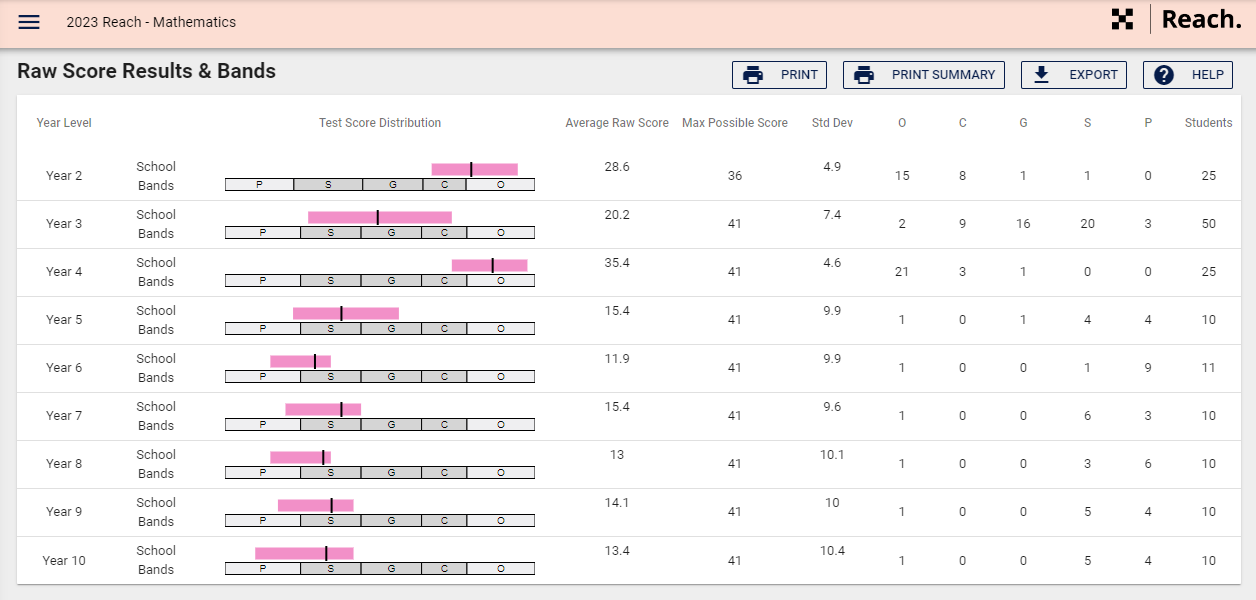 A screenshot from a Reach report, which shows students’ test scores against the nation’s average, their standard deviation, and more.
A screenshot from a Reach report, which shows students’ test scores against the nation’s average, their standard deviation, and more.
To help tackle the growing inequity in Australia’s education system, we are working together with the University of Sydney to provide over 5,000 free Reach tests to students in remote and regional NSW schools, as part of our Data-led Education Equity Program (DEEP). This will help those schools to measure student performance on foundational skills like literacy and numeracy, as well as STEM-specific skills such as those found in science and digital technologies. If you’d like to learn about the eligibility criteria for DEEP, you can do so here.
5. Build relationships with local STEM businesses
There may be a number of local businesses that can help to build enthusiasm for STEM in your school, or provide opportunities in the form of work experience, apprenticeships and junior roles.
Energy companies, manufacturers, software firms, agricultural businesses – they all need people with STEM skills to help their companies thrive. They might be willing to visit your school and talk about what their company does, and the various careers and roles of their staff. You might ask if students can visit the companies on a field trip to actually witness what goes on. You might talk about the potential opportunities they can offer your students after they graduate, or even discuss the possibility of funding STEM classes at your school, which could lead to reams of skilled graduates ready to work for them.
STEM learning is a crucial aspect of modern education, whether taught as individual subjects or a combined unit. It develops vital real-world skills that will be needed by companies in Australia and beyond. We hope this article has adequately stressed its importance and given you some guidance on how improve STEM learning in your school.
Good luck!
Mary-Anne is a former primary teacher who taught across years Kindergarten to 6 as a Science and Technology specialist. Her work was included as a case-study in the 2016 report created by the University of Technology, Sydney, on “Quality Learning and Teaching in Primary Science and Technology” under the pseudonym “Suzie”. Mary-Anne has leveraged her passion for designing learning experiences for students to impact the student assessment experience at Janison.
References
- 2023, Review of the National School Reform Agreement, Australian Government Productivity Commission
- Judith Hallinen, STEM, Brittanica
- 2015, Future-proofing Australia’s workforce by growing skills in science, technology, engineering and maths (STEM), PricewaterhouseCoopers
- 2015, National STEM School Education Strategy, Education Council
- Arthur Herman, 2019, America’s STEM Crisis Threatens Our National Security, American Affairs Journal
- 2016, How schools can improve literacy and numeracy performance and why it (still) matters, NSW Government Centre for Education Statistics & Evaluation
- David Adams, 2022, STEM industry leaders gather to tackle skills gap, Information Age
Tag:STEM


